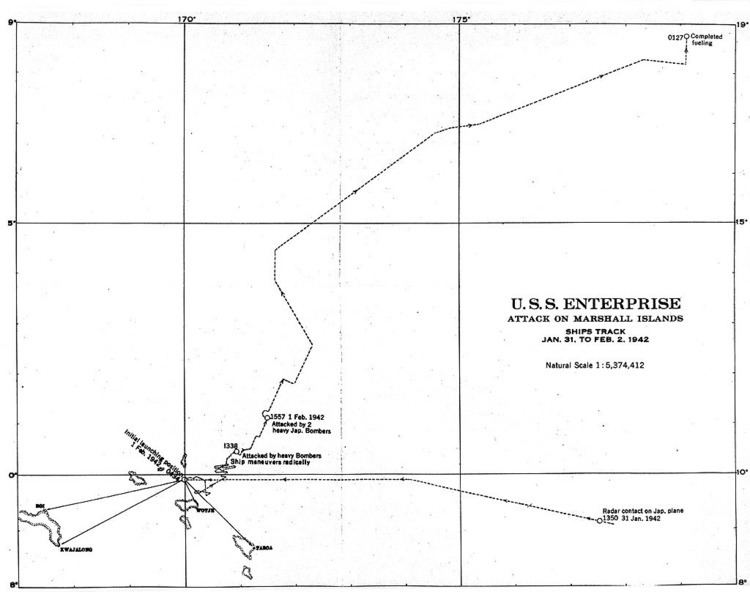Date 1 February 1942 | ||
 | ||
1 cruiser damaged,14 aircraft destroyed 3 auxiliary ships sunk,1 minelayer,1 light cruiser damaged,4 transports,2 auxiliary ships damaged,18 aircraft destroyed Combatants United States of America, Japan, Empire of Japan Similar World War II, Pacific War, Battle of the Malacca, Operation Tiderace, Gilbert and Marshall Islands c | ||
Marshalls gilberts raids
The Marshalls–Gilberts raids were tactical airstrikes and naval artillery attacks by United States Navy aircraft carrier and other warship forces against Imperial Japanese Navy (IJN) garrisons in the Marshall and Gilbert Islands on 1 February 1942. The Japanese garrisons were under the overall command of Vice Admiral Shigeyoshi Inoue, commander of the 4th Fleet. Japanese aircraft in the islands belonged to the IJN's 24th Air Flotilla under Rear Admiral Eiji Gotō. The U.S. warship forces were under the overall command of Vice Admiral William Halsey, Jr.
Contents
Raids
The raids were carried out by two separate U.S. carrier task forces. Aircraft from Task Force 17 (TF 17), commanded by Rear Admiral Frank Jack Fletcher and centered on the carrier USS Yorktown, attacked Jaluit, Mili, and Makin (Butaritari) islands. The Yorktown aircraft inflicted moderate damage to the Japanese naval installations on the islands and destroyed three aircraft. Seven Yorktown aircraft were lost, as well as a floatplane from one of TF 17's cruisers.
Aircraft from TF 8, commanded by Halsey and centered on the carrier USS Enterprise, struck Kwajalein, Wotje, and Taroa. At the same time, cruisers and destroyers bombarded Wotje and Taroa. The strikes inflicted light to moderate damage on the three islands' naval garrisons, sank three small warships and damaged several others, including the light cruiser Katori, and destroyed 15 Japanese aircraft. The heavy cruiser USS Chester was hit and slightly damaged by a Japanese aerial bomb, and six Enterprise aircraft were lost. TFs 8 and 17 retired from the area immediately upon completion of the raids.
Aftermath and significance
The raids had little long-term strategic impact. The IJN briefly sent two aircraft carriers to chase TFs 8 and 17, but quickly abandoned the pursuit and continued their support for the ongoing, successful conquests of the Philippines and Netherlands East Indies. The raids, however, did help lift the morale of the U.S. Navy and American public, still reeling from the Pearl Harbor attack and loss of Wake Island. The raids also provided valuable experience in carrier air operations, which hardened the U.S. carrier groups for future combat against Japanese forces. For their part, the Japanese apparently did not realize that their concept of a perimeter defense using dispersed island garrisons had serious flaws in that the garrisons were too far apart to be sufficiently mutually supporting to prevent penetration by enemy carrier forces. The raids, along with the Doolittle Raid in April 1942, helped convince the IJN's Combined Fleet commander, Isoroku Yamamoto, that he needed to draw the American carriers into battle as soon as possible in order to destroy them. Yamamoto's plan to do so resulted in the Battle of Midway.
